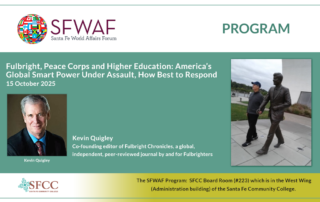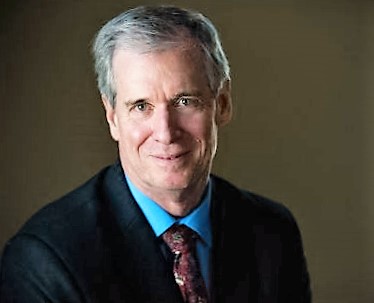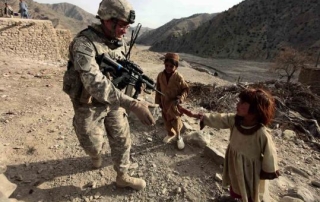Fulbright, Peace Corps and Higher Education: America’s Global Smart Power Under Assault, How Best to Respond
Wednesday, October 15, 2025 from 12:00 noon – 2 pm
Kevin Quigley
Kevin Quigley is former college president of Marlboro College where he led its merger with Emerson College. As president of the National Peace Corps Association, he led the national campaign resulting in the Peace Corps’ largest appropriation increase in history. He has been a three-time Fulbright Senior Specialist and a Fulbright Association board member and was the first executive director of the Global Alliance for Workers and Communities, where he pioneered a tri-sectoral partnership among global corporations, governments, and civil society organizations designed to improve global workplace conditions.
He is co-founding editor of Fulbright Chronicles, a global, independent, peer- reviewed journal by and for Fulbrighters (www.fulbright-chronicles.com); and with his wife, Susan Flaherty, founded the Peace Corps Commemorative Foundation www.peacecorpscommemorative.org), now a Peace Corps community effort to build the Peace Corps Park near the National Mall as a testament to the historic and enduring importance of service and international understanding in the United States’ engagement with the world.
He has extensive teaching and publishing experience on international service, democratization, and higher education issues. Quigley has served on various university boards, including the New England Board of Education, American University of Nigeria, American University of Afghanistan, Parami University (Myanmar), and Swarthmore College. He has degrees from Georgetown University, Columbia University, University College Dublin, and Swarthmore College.
Registration: This SFWAF lunch is $26 for members and $36 for nonmembers. You may pay by check made out to SFWAF and mailed to The Santa Fe World Affairs Forum, Santa Fe, PO Box 31965, NM 87594 or with a credit card using our Paypal account. Please indicate on your check or if using Paypal please note in “add special instructions to the seller” that your payment is for the Thursday, October 16, 2025 program.
Members: if you have not yet paid your 2025-26 membership dues, you may include the $50 per person annual dues in your payment for this program, but please also note in special instructions that dues are included. Because we are a 501(c)(3) organization, dues and contributions are tax deductible in accordance with IRS regulations.
If you are not a member or plan to bring a guest who is not a member, please include your best contact information and your guest’s name. We use nametags. If you are interested in membership, please email us: sfwaforum@outlook.com.
Payment for this program is non-refundable after Friday October 10, 2025 . We strongly prefer that payment be made by Paypal or check postmarked by October 10, 2025 at the latest to facilitate check in. It is also very helpful if you are sending a check to email us at sfwaforum@outlook.com to let us know you plan to attend.
If you are not a member but interested in membership, please see our membership page and email sfwaforum@outlook.com for additional information.
Because we are a 501(c)(3) organization, dues and contributions are tax deductible.
For pricing and reservations, click here: https://sfwaf.org/payment/
Location: SFCC Board Room (#223) is in the West Wing (Administration building). The college is located at 6401 Richards Avenue, Santa Fe, NM 87508. Enter through the building’s main entrance (on the left side of the building behind the flag poles). The Board Room is on the corridor to the left of the Campus Center.
Directions: From Rodeo Road turn south onto Richards Avenue. Turn into the campus main drive. Parking lots are in front of the building. From I-25 take the Cerrillos Road exit, turn east onto Governor Miles Road and then right onto Richards Avenue. Then follow directions above.





